
Aluterus scriptus, commonly known as scrawled filefish, broomtail filefish or scribbled leatherjacket, is a marine fish belonging to the family Monacanthidae.

Corella willmeriana is a solitary tunicate in the family Corellidae. It is native to the eastern Pacific Ocean where it lives on the seabed at depths down to about 75 m (250 ft) between Alaska and California.

Nembrotha lineolata is a species of nudibranch, a sea slug, a marine gastropod mollusk in the family Polyceridae. It is found in shallow water in the Indo-Pacific. It was first described in 1905 by the Danish malacologist Rudolph Bergh. The type locality is Selayar Island, Indonesia.

Clavelina picta, common name the painted tunicate, is a species of tunicate, in the genus Clavelina. These animals, like all ascidians, are sessile filter feeders.

Clavelina robusta is a species of tunicate, in the genus Clavelina. Like all ascidians, these sessile animals are filter feeders.

Pycnoclavella diminuta, known as the white-spotted sea squirt, white-spot ascidian, and white-spotted ascidian, is a species of tunicate, in the genus Pycnoclavella. Like all ascidians, these sessile animals are filter feeders.

Atriolum robustum is a colonial tunicate or sea squirt in the family Didemnidae. It is native to the western and central Indo-Pacific where it is usually found anchored to a hard surface in shallow water.
Maritigrella crozierae, the tiger flatworm, is a species of marine polyclad flatworm in the family Euryleptidae. It is found on the eastern coasts of North America and the Caribbean Sea where it feeds on colonial sea squirts.

Didemnum vexillum is a species of colonial tunicate in the family Didemnidae. It is commonly called sea vomit, marine vomit, pancake batter tunicate, or carpet sea squirt. It is thought to be native to Japan, but it has been reported as an invasive species in a number of places in Europe, North America and New Zealand. It is sometimes given the nickname "D. vex" because of the vexing way in which it dominates marine ecosystems when introduced into new locations, however the species epithet vexillum actually derives from the Latin word for flag, and the species was so named because of the way colonies' long tendrils appear to wave in the water like a flag.
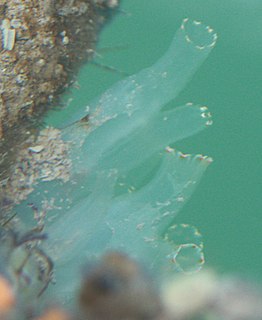
Ciona savignyi is a marine animal sometimes known as the Pacific transparent sea squirt or solitary sea squirt. It is a species of tunicates in the family Cionidae. It is found in shallow waters around Japan and has spread to the west coast of North America where it is regarded as an invasive species.
Perophora japonica is a species of colonial sea squirt in the genus Perophora, native to the North Indo-Pacific. It has spread to several other parts of the world including the south coast of Britain, France, the Netherlands and the west coast of the United States.
Synoicum pulmonaria, the tennis ball ascidian or sea-fig, is a species of colonial sea squirt, a tunicate in the family Polyclinidae. It occurs in shallow water in the northeastern Atlantic Ocean, the North Sea and the English Channel, and also, to a lesser extent, in the northwestern Atlantic Ocean.
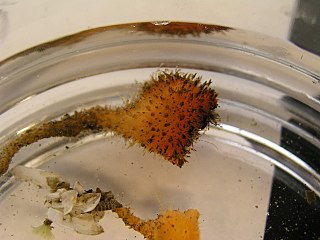
Boltenia villosa is a species of tunicate, a marine invertebrate of the family Pyuridae. Common names include the spiny-headed tunicate, the hairy sea squirt, the stalked hairy sea squirt and the bristly tunicate. This species was first described in 1864 by the American marine biologist William Stimpson who gave it the name Cynthia villosa. It was later transferred to the genus Boltenia. The type locality is Puget Sound, Washington state, United States.
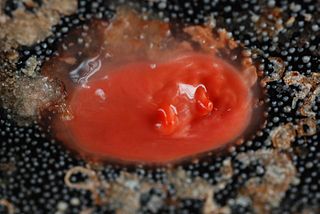
Cnemidocarpa finmarkiensis is a species of solitary ascidian tunicate in the family Styelidae. Common names include broad base sea squirt, orange sea squirt, red sea squirt, shiny orange sea squirt, shiny red tunicate and Finmark's tunicate. It is native to shallow waters in the northern and northeastern Pacific Ocean.

Pyura haustor is a species of sessile ascidian, or sea squirt, that lives in coastal waters in the north-eastern Pacific Ocean, attached to rocks or artificial structures. Common names for this species include the wrinkled seapump, the wrinkled sea squirt and the warty tunicate.

Boltenia echinata, commonly known as the cactus sea squirt, is a species of tunicate, a marine invertebrate in the genus Boltenia of the family Pyuridae. It is native to the Arctic Ocean and the northern Atlantic Ocean.
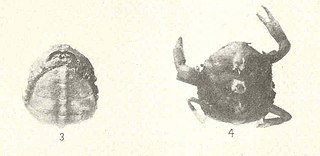
Tunicotheres is a monotypic genus of crabs in the family Pinnotheridae, and Tunicotheres moseri is the only species in the genus. This crab lives commensally in the atrial chamber of a small ascidian. It is found in the tropical western Atlantic Ocean, the Caribbean Sea and the Gulf of Mexico.
Halocynthia igaboja, commonly known as the sea hedgehog, the bristly tunicate or spiny sea squirt, is a species of tunicate in the family Pyuridae. It is native to the northeastern Pacific Ocean. This species was first described in 1906 by the Japanese marine biologist Asajiro Oka, who gave it the name Cynthia ritteri. It was later transferred to the genus Halocynthia.
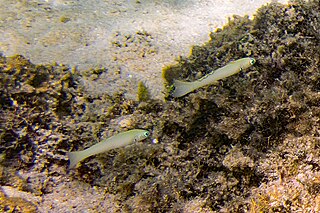
Ptereleotris microlepis is a species of the fish family Gobiidae.















